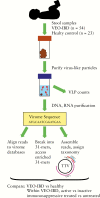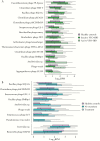Dynamics of the Stool Virome in Very Early-Onset Inflammatory Bowel Disease
- PMID: 32406906
- PMCID: PMC7648169
- DOI: 10.1093/ecco-jcc/jjaa094
Dynamics of the Stool Virome in Very Early-Onset Inflammatory Bowel Disease
Abstract
Background and aims: Dysbiosis of the gut microbiota is a well-known correlate of the pathogenesis of inflammatory bowel disease [IBD]. However, few studies have examined the microbiome in very early-onset [VEO] IBD, which is defined as onset of IBD before 6 years of age. Here we focus on the viral portion of the microbiome-the virome-to assess possible viral associations with disease processes, reasoning that any viruses potentially associated with IBD might grow more robustly in younger subjects, and so be more detectable.
Methods: Virus-like particles [VLPs] were purified from stool samples collected from patients with VEO-IBD [n = 54] and healthy controls [n = 23], and characterized by DNA and RNA sequencing and VLP particle counts.
Results: The total number of VLPs was not significantly different between VEO-IBD and healthy controls. For bacterial viruses, the VEO-IBD subjects were found to have a higher ratio of Caudovirales vs to Microviridae compared to healthy controls. An increase in Caudovirales was also associated with immunosuppressive therapy. For viruses infecting human cells, Anelloviridae showed higher prevalence in VEO-IBD compared to healthy controls. Within the VEO-IBD group, higher levels of Anelloviridae DNA were also positively associated with immunosuppressive treatment. To search for new viruses, short sequences enriched in VEO-IBD samples were identified, and some could be validated in an independent cohort, although none was clearly viral; this provides sequence tags to interrogate in future studies.
Conclusions: These data thus document perturbations to normal viral populations associated with VEO-IBD, and provide a biomarker-Anelloviridae DNA levels-potentially useful for reporting the effectiveness of immunosuppression.
Keywords: VEO-IBD; Very early-onset inflammatory bowel disease; metagenome; microbiome; virome.
© The Author(s) 2020. Published by Oxford University Press on behalf of European Crohn’s and Colitis Organisation. All rights reserved. For permissions, please email: journals.permissions@oup.com.
Figures





Similar articles
-
Gut virome-wide association analysis identifies cross-population viral signatures for inflammatory bowel disease.Microbiome. 2024 Jul 18;12(1):130. doi: 10.1186/s40168-024-01832-x. Microbiome. 2024. PMID: 39026313 Free PMC article.
-
The gut virome in inflammatory bowel diseases.Curr Opin Virol. 2021 Dec;51:190-198. doi: 10.1016/j.coviro.2021.10.005. Epub 2021 Nov 8. Curr Opin Virol. 2021. PMID: 34763180 Review.
-
The intestinal microbiome of inflammatory bowel disease across the pediatric age range.Gut Microbes. 2024 Jan-Dec;16(1):2317932. doi: 10.1080/19490976.2024.2317932. Epub 2024 Feb 25. Gut Microbes. 2024. PMID: 38404111 Free PMC article.
-
Metagenomic analysis of intestinal mucosa revealed a specific eukaryotic gut virome signature in early-diagnosed inflammatory bowel disease.Gut Microbes. 2019;10(2):149-158. doi: 10.1080/19490976.2018.1511664. Epub 2018 Sep 25. Gut Microbes. 2019. PMID: 30252582 Free PMC article.
-
A systematic review on the role of gut microbiome in inflammatory bowel disease: Spotlight on virome and plant metabolites.Microb Pathog. 2025 Aug;205:107608. doi: 10.1016/j.micpath.2025.107608. Epub 2025 Apr 16. Microb Pathog. 2025. PMID: 40250496
Cited by
-
The Role of Viruses in the Pathogenesis of Immune-Mediated Gastro-Intestinal Diseases.Int J Mol Sci. 2024 Jul 30;25(15):8301. doi: 10.3390/ijms25158301. Int J Mol Sci. 2024. PMID: 39125870 Free PMC article. Review.
-
Interpersonal variability of the human gut virome confounds disease signal detection in IBD.Commun Biol. 2023 Feb 25;6(1):221. doi: 10.1038/s42003-023-04592-w. Commun Biol. 2023. PMID: 36841913 Free PMC article.
-
The Human Virome: Viral Metagenomics, Relations with Human Diseases, and Therapeutic Applications.Viruses. 2022 Jan 28;14(2):278. doi: 10.3390/v14020278. Viruses. 2022. PMID: 35215871 Free PMC article. Review.
-
Features of the gut prokaryotic virome of Japanese patients with Crohn's disease.J Gastroenterol. 2022 Aug;57(8):559-570. doi: 10.1007/s00535-022-01882-8. Epub 2022 Jun 11. J Gastroenterol. 2022. PMID: 35689701
-
Metapath Aggregated Graph Neural Network and Tripartite Heterogeneous Networks for Microbe-Disease Prediction.Front Microbiol. 2022 May 31;13:919380. doi: 10.3389/fmicb.2022.919380. eCollection 2022. Front Microbiol. 2022. PMID: 35711758 Free PMC article.
References
MeSH terms
Substances
Grants and funding
LinkOut - more resources
Full Text Sources
Medical

